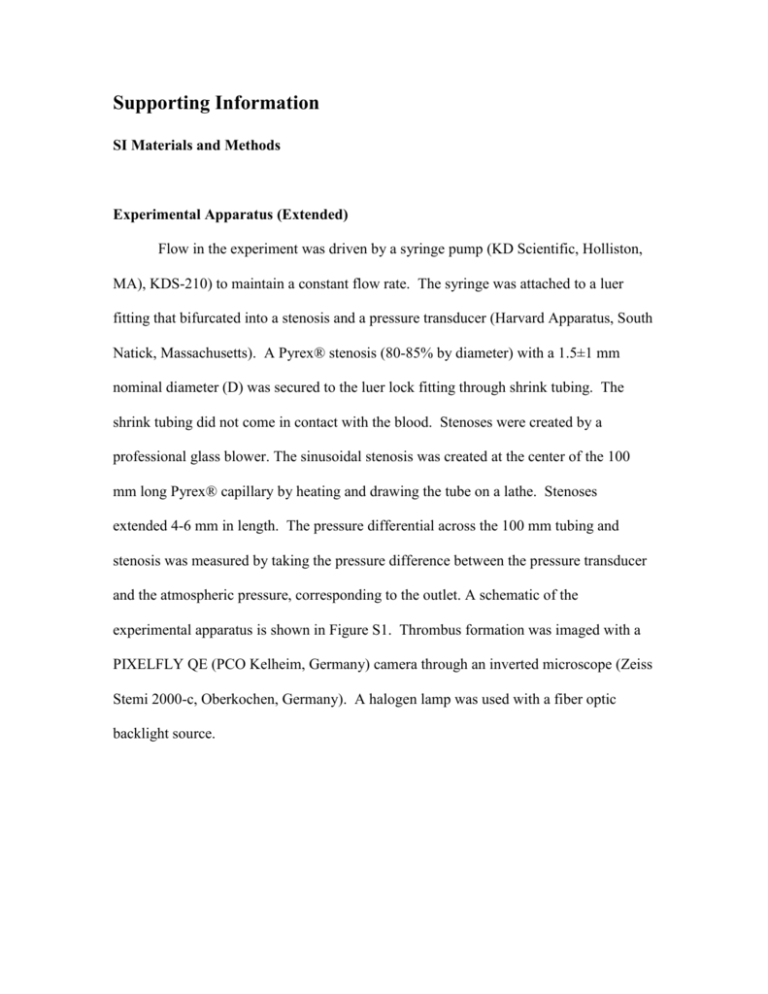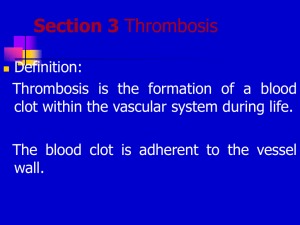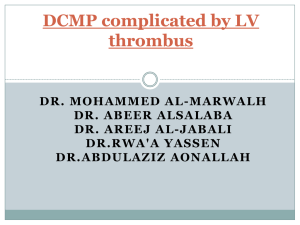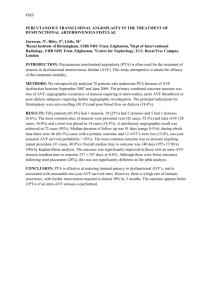bit_24537_sm_SupplInfo
advertisement

Supporting Information SI Materials and Methods Experimental Apparatus (Extended) Flow in the experiment was driven by a syringe pump (KD Scientific, Holliston, MA), KDS-210) to maintain a constant flow rate. The syringe was attached to a luer fitting that bifurcated into a stenosis and a pressure transducer (Harvard Apparatus, South Natick, Massachusetts). A Pyrex® stenosis (80-85% by diameter) with a 1.5±1 mm nominal diameter (D) was secured to the luer lock fitting through shrink tubing. The shrink tubing did not come in contact with the blood. Stenoses were created by a professional glass blower. The sinusoidal stenosis was created at the center of the 100 mm long Pyrex® capillary by heating and drawing the tube on a lathe. Stenoses extended 4-6 mm in length. The pressure differential across the 100 mm tubing and stenosis was measured by taking the pressure difference between the pressure transducer and the atmospheric pressure, corresponding to the outlet. A schematic of the experimental apparatus is shown in Figure S1. Thrombus formation was imaged with a PIXELFLY QE (PCO Kelheim, Germany) camera through an inverted microscope (Zeiss Stemi 2000-c, Oberkochen, Germany). A halogen lamp was used with a fiber optic backlight source. P Pressure Transducer Q Syringe Pump Patm Stenosis Figure S1: Schematic of the experimental apparatus. A syringe pump is used to provide a constant flow rate of blood, which is perfused through silicone tubing into a stenosis. A pressure transducer is placed upstream of the stenosis. The end of the stenosis-containing tube is exposed to atmosphere. The pressure differential between the transducer and atmospheric pressure, provides the pressure drop across the stenosis. The system results in an upstream Reynolds number (Re) ranging from 0.95 to 2.1. An entrance length for flow development was included by extending straight tubing 30 diameters (45 mm) upstream and downstream of the stenosis section. The theoretical entrance length for fully developed velocity (0.06 Re*D ) is only 1.2 D (0.2 mm), while near-wall platelet concentrations have been shown to develop within 25 diameters (37.5 mm) for a 40% hematocrit at a Re of 2 (Zhao, Kameneva et al. 2007). Thus, the entrance region of the test section should allow for a fully developed platelet concentration profile. Growth Quantification (Extended) Thrombus thickness is measured once every second using light microscopy. Whole blood can be distinguished from thrombus or glass because less light is transmitted through whole blood. The images were post-processed using Matlab (ver 7.0.1.24704 R14 Service Pack 1; The Mathworks, Inc., Natick, MA). The method utilized for determining the initial stenosis edge and subsequent thrombus edge is diagramed in Figure S2. To determine the glass wall of the test section, the pixels in the initial blood perfusion image were first averaged with the first 5 images temporally. Averaging aided in filtering out noise. Subsequently, the initial lumen edge was determined through the Sobel gradient method using the Matlab edge function. The pixel physical dimension was determined by the number of pixels spanning the known outer diameter of the capillary, where no refraction exists (#pixels/(2 Ro)). Therefore, the perceived inner radius, y, of the vessel is known by multiplying the pixel size by the number of pixels. The cylindrical nature of the capillary creates refraction in the image, which was corrected through Snell’s law. Figure S2: Schematic of the edge detection technique. The number of pixels that existed along the initial outer diameter (OD) of the test sample and the observed inner diameter (ID) of the stenosis were counted across the images. The number of pixels across the known OD was used to determine the pixel size. Snell’s law was assumed for correction of the ID refraction. The next image in the time sequence was aligned with the original image to allow for image subtraction. Noise was minimized by filtering the subtracted image. The thrombus edge was determined based an intensity threshold and intensity gradient technique for the subtracted image. Refraction of the thrombus edge was accounted for by altering the edge location through Snell’s law. Computational fluid dynamics (CFD) was used to then determine the pressure drop across the growing thrombus. If the pressure drop matched the experimental pressure drop with respect to time, then the CFD results were related back to the growth of thrombus. However, if the pressure computations did not match the experimental measurements, the edge intensity threshold was adjusted and thrombus edges were adjusted. To determine the thrombus edge, subsequent snapshots were averaged with the nearest 5 images. Images were registered and the initial non-thrombosed snapshot was subtracted from subsequent images to filter out features that are consistent through all images, thus providing a cleaner picture for edge detection. After applying a Gaussian filter to smooth out sharp changes in the subtracted image, we defined a perceived thrombus edge based on a light intensity threshold technique. Any transmitted light below a threshold value was considered to be whole blood. The transition from whole blood to thrombus or glass was considered an edge. Refraction was corrected for through Snell’s law, similar to the initial inner diameter of the tube. The optical refraction led to corrections of up to 45%. The edge detection threshold was adjusted to best match time dependent pressure measurements. Refraction Correction Optical viewing of the inner edges of the stenosis is distorted by refraction and therefore Snell’s law is used to correct this phenomenon. A conversion from the perceived stenosis radius, y, to the actual stenosis radius, y’, was determined by considering light transmitted through air and the glass capillary: Equation 1 y ' y Ro cos tan y R o arcsin nair y n pyrex Ro arcsin where y is the perceived inner radius of the vessel, Ro is the outer physical radius of the vessel, and nair is the refractive index of air, taken as 1. The refractive index of the stenosis, npyrex, which was created by heating glass, was determined by solving for npyrex in Equation 1, assuming that y’ was the non-stenosed inner radius of the vessel (750 m). The refractive index of the glass was measured for all 5 stenoses in case heating the glass altered the refractive index from published results. Our measurements yielded an average of 1.45, a value consistent with the published refractive index for Pyrex®. Refraction of thrombus was corrected through Snell’s law, similar to Equation 1, except temporally later edges are observed through an additional layer of thrombus. Therefore, the updated equation for refraction correction of a thrombus edge was determined by solving: Equation 2 y ' Ri sin Ri cos tan nair y arcsin n pyrex Ri n R thrombosis i arcsin nair y where Ri is the initial lumen radius of the vessel determined through y’ of Equation 1. The refractive index of thrombosis was taken as 1.4 based on the refractive index of platelets (Kolesnikova, Potapov et al. 2006). CFD: Hemodynamic quantification of instantaneous shear rate Hemodynamic conditions change over time because thrombi superimpose the initial stenosis, which effectively changes the wall boundary for the flow of blood. Using the thrombus edge as a wall boundary for CFD and experimental flow rates as an inlet condition, we obtain computed results of the flow field every 10 seconds. To create a CFD solution of the flow field, a mesh was developed in the region of blood flow based on the thrombus and stenosis boundary, using Gambit 2.4.6 (ANSYS Santa Clara, CA). A structured mesh was created in the boundary layer, transitioning into an unstructured triangular mesh in the stenosis region near the core of the vessel. An unstructured quadrangle mesh was placed upstream and downstream to the stenosis. The mesh resolution was increased until a mesh independent solution was obtained. To compute the flow field, the incompressible Navier-Stokes equations were solved using a second order upwind scheme in the finite-volume based commercial computational fluid dynamics (CFD) package, Fluent 6.3.26 (ANSYS Santa Clara, CA). SIMPLE velocity-pressure coupling was used. The solution was assumed to converge when continuity and velocity component residuals dropped below 10-10. Convergence was also verified with mass balance between the inlet and outlet. Two-dimensional axisymmetry was assumed with a lumen diameter corresponding to the distance between detected thrombus or stenosis edges. The flow in the CFD solution was assumed to be laminar because upstream Re in our system remained below 2, which is well below the turbulence transition upstream Re for a stenosis (Young 1979). Blood was considered Newtonian because shear rates in the flow field were sufficiently high to break up rouleux, thus minimizing non-Newtonian phenomena. Thrombus growth has the potential to create unsteady flow if the boundary changes at a high enough speed. However, thrombus growth rates found in this study generally do not exceed 0.5 m/s, which can be compared with average inlet blood velocities of 5,000 m/s. Therefore, unsteady effects from thrombus growth are negligible relative to convection in the current study. A lumen reduction below 100 m is known to affect blood viscosity (Pries, Secomb et al. 1994). Therefore, the analysis was stopped when the thrombus reduced the inner diameter of the flow below 100 m. Correction of thrombus edge detection by pressure drop The edges of thrombi are not distinct in optical images, similar to many machine vision applications. Therefore, our method of edge detection was verified to obtain the most accurate edge choices within the limitations of the techniques used in this study. To verify our edge choice, the pressure drop determined through computational evaluation of flow through the stenosis and thrombi was compared with the experimental pressure drop across the same region. The pressure drop is a sensitive parameter for verifying a radius because simple Hagen-Poiseuille flow assumptions and blunt plug stenoses relate the pressure drop to a constant flow rate by the inverse of the radius to the fourth power (Young 1979). The optical intensity threshold used for edge detection was adjusted in cases where the computed pressure drop varied by more than 30% of the measured pressure drop, which would correspond to a radius offset of only 2.3% based on the fourth power assumption. The process of detecting an edge was reiterated until pressure drops were within the specified bounds based on the updated intensity thresholds. Thrombus growth rates predicted from transport, assuming 100% platelet binding efficiency An analytical expression for platelet deposition rates based on transport is used to predict the how fast thrombus can deposit from transport alone, assuming a platelet that arrives at the vessel/thrombus wall instantly binds and remains bound. Turitto and Baumgartner (Turitto and Baumgartner 1975) estimated that the flux of platelets to a surface based on idealized transport (e.g. steady and fully developed flow with axial convection dominance over axial diffusion) as: D 2 J transport 0.67C0 2z 1/ 3 The effective diffusion of platelets is enhanced because of red blood cells. Zydney and Colton (Zydney and Colton 1988) collected platelet transport data from multiple experiments and determined a relationship of effective diffusion to shear rates, hematocrit, and platelet diameter: D a 2 0.15 1 0.8 After assuming that z is the length from initial collagen coating to the stenosis apex (i.e. 1.5 mm) and after inserting the average porcine blood values for platelet concentration (C0=210±74 million platelets per ml), hematocrit (), and effective platelet diameter (a=(0.75)*( 8.8±1.0 m3)(1/3)), one can arrive at the rate of platelets reaching a fully adherent substrate. The equations are combined, providing the idealized platelet deposition rate near the stenosis peak, J=0.003*(WSR) m3/m2-min, where WSR is in units of inverse seconds. References Kolesnikova, I., S. Potapov, et al. (2006). "Determination of volume, shape and refractive index of individual blood platelets." Journal of Quantitative Spectroscopy and Radiative Transfer 102(1): 37-45. Pries, A. R., T. W. Secomb, et al. (1994). "Resistance to blood flow in microvessels in vivo." Circ Res 75(5): 904-915. Turitto, V. T. and H. R. Baumgartner (1975). "Platelet deposition on subendothelium exposed to flowing blood: mathematical analysis of physical parameters." Transactions - American Society for Artificial Internal Organs. 21: 593-601. Young, D. F. (1979). "Fluid mechanics of arterial stenoses." Transactions of the ASME. Journal of Biomechanical Engineering 101(3): 157-175. Zhao, R., M. V. Kameneva, et al. (2007). "Investigation of platelet margination phenomena at elevated shear stress." Biorheology 44(3): 161-177. Zydney, A. L. and C. K. Colton (1988). "Augmented solute transport in the shear flow of a concentrated suspension." PhysicoChemical Hydrodynamics 10(1): 77-96.








